Definition
Fowl birds, commonly referred to as poultry, encompass various species primarily raised for their eggs, meat, or both. These avian creatures have been domesticated for centuries, playing a vital role in agriculture and food production worldwide.
Historical Significance
The history of fowl birds traces back to ancient times, where they were first domesticated for food and other purposes. From the early domestication of wild fowl to the development of specialized breeds, the journey of fowl birds intertwines with human civilization, shaping culinary traditions and agricultural practices.
Popular Breeds of Fowl Birds
Chicken Breeds
Chickens are indeed among the most versatile and widely raised fowl birds, offering a plethora of breeds tailored for specific purposes such as egg-laying, meat production, or ornamental display. Whether you’re a backyard enthusiast or a commercial farmer, there’s a chicken breed suited to meet your needs.
Egg-Laying Breeds
Rhode Island Red: Known for their exceptional egg-laying capabilities, Rhode Island Reds are a popular choice among poultry keepers seeking a reliable source of fresh eggs. These birds are renowned for their hardiness, adaptability, and consistent egg production, making them ideal for both small-scale and commercial egg farming operations.

Leghorn: Leghorns are prized for their prolific egg-laying abilities, with some hens laying up to 300 large white eggs per year. These energetic and independent birds thrive in free-range environments and are valued for their efficient feed conversion, making them an economical choice for egg production.
Plymouth Rock: Plymouth Rocks, also known as Barred Rocks, are dual-purpose chickens prized for their excellent egg-laying and meat-producing qualities. These docile and friendly birds lay large brown eggs consistently throughout the year, making them a favorite among backyard poultry enthusiasts.
Meat-Producing Breeds
Cornish Cross: Cornish Cross chickens are the go-to breed for meat production due to their rapid growth rates and impressive meat yield. Bred specifically for meat, these birds reach market weight in as little as 6-8 weeks, making them highly efficient for commercial broiler operations.
Sussex: Sussex chickens are renowned for their flavorful and tender meat, making them a popular choice among small-scale farmers and backyard poultry keepers. While they may not grow as quickly as Cornish Cross chickens, Sussex birds offer excellent meat quality and can also be raised for dual-purpose production.
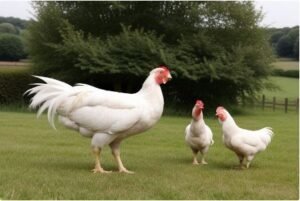
Orpington: Orpington chickens are known for their large size, gentle disposition, and succulent meat. Although they excel as dual-purpose birds, Orpingtons are particularly prized for their meat-producing qualities, with plump breasts and rich flavor that make them a favorite for roasting and grilling.
Ornamental Breeds
Silkie: Silkie chickens are beloved for their fluffy plumage, distinctive appearance, and gentle temperament. While they may not be prolific egg layers or efficient meat producers, Silkies are prized for their ornamental value and are often kept as pets or exhibition birds.
Polish: Polish chickens are easily recognizable by their striking crest of feathers atop their heads. These quirky and entertaining birds are primarily kept for their ornamental value, though they may also lay small to medium-sized white eggs.

Serama: Serama chickens are the smallest chicken breed in the world, making them a favorite among collectors and enthusiasts of miniature poultry. Despite their diminutive size, Seramas are active and energetic birds with charming personalities, making them popular pets and exhibition birds.
Whether you’re interested in maximizing egg production, raising birds for meat, or simply adding some flair to your flock with ornamental breeds, there’s a chicken breed suited to meet your needs and preferences.
Duck Breeds
Ducks are highly adaptable birds known for their versatility, flavorful meat, and ability to thrive in diverse environments. Whether you’re interested in raising ducks for meat, eggs, ornamental purposes, or pest control, there’s a breed suited to meet your needs.
Meat-Producing Breeds
Pekin: Pekin ducks are perhaps the most popular breed for meat production due to their rapid growth rates, plump bodies, and tender, flavorful meat. These large white ducks are known for their docile nature and adaptability to various climates, making them a favorite among commercial duck farmers.
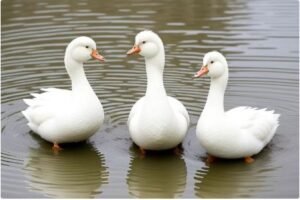
Muscovy: Muscovy ducks are prized for their lean, succulent meat and unique appearance. Unlike other duck breeds, Muscovies are native to South America and have distinct red facial caruncles and a pronounced flavor profile. They are excellent foragers and can be raised for both meat and pest control purposes.
Rouen: Rouen ducks are often raised for their gourmet-quality meat, which is known for its rich flavor and tender texture. Similar in appearance to Mallards but larger in size, Rouens are valued for their efficient feed conversion and calm temperament, making them suitable for small-scale meat production operations.
Egg-Laying Breeds
Khaki Campbell: Khaki Campbell ducks are renowned for their exceptional egg-laying abilities, with some hens laying up to 300 eggs per year. These efficient layers produce large white or tinted eggs and are prized for their high productivity, making them an ideal choice for backyard egg farming enthusiasts.

Indian Runner: Indian Runner ducks are known for their upright posture and distinctive walking style, resembling that of penguins. While they may not lay as many eggs as Khaki Campbells, Indian Runners are valued for their consistent egg production and adaptability to various environments.
Ornamental and Exhibition Breeds
Call Duck: Call ducks are miniature ducks prized for their adorable appearance and charming personalities. Despite their small size, Call ducks come in a variety of color patterns and are popular as pets and exhibition birds.
Crested Duck: Crested ducks, as the name suggests, are distinguished by the tuft of feathers atop their heads. These quirky and eye-catching ducks are primarily kept for ornamental purposes and are often featured in poultry shows and exhibitions.
Cayuga: Cayuga ducks are known for their striking iridescent green-black plumage, making them one of the most visually appealing duck breeds. While they are suitable for egg production and meat, Cayugas are also valued for their ornamental value and are often kept for display purposes.

Turkey Breeds
Turkeys are revered for their large size, flavorful meat, and iconic presence during holiday feasts and special occasions. Whether you’re a commercial farmer or a backyard enthusiast, there are several turkey breeds to consider, each with its own unique qualities and suitability for different purposes.
Meat-Producing Breeds
Broad Breasted White: The Broad Breasted White turkey is perhaps the most common breed raised for meat production. Known for its broad breast and ample muscle development, this breed offers a high meat-to-bone ratio, making it a favorite among commercial turkey growers. Broad Breasted Whites are prized for their tender, juicy meat and are typically ready for processing within 14 to 18 weeks.
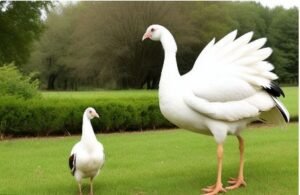
Bronze: Bronze turkeys are renowned for their rich flavor, succulent meat, and distinctive bronze-colored plumage. While they may take longer to reach market weight compared to Broad Breasted Whites, Bronze turkeys are valued for their excellent foraging abilities and traditional heritage breed qualities. They are often raised on pasture and are favored by small-scale farmers and heritage breed enthusiasts.
Narragansett: The Narragansett turkey is known for its striking coloration, calm temperament, and flavorful meat. With its distinctive black, gray, and white feathering, this heritage breed offers both aesthetic appeal and culinary excellence. Narragansetts are valued for their ability to thrive in free-range environments and are prized for their rich, well-marbled meat.
Dual-Purpose Breeds
Bourbon Red: Bourbon Red turkeys are a popular dual-purpose breed prized for their flavorful meat and prolific egg-laying capabilities. With their attractive mahogany-red plumage and friendly disposition, Bourbon Reds are equally well-suited for both meat production and egg farming. They are often raised on small farms and homesteads for their versatility and heritage breed qualities.
Royal Palm: Royal Palm turkeys are known for their striking appearance, featuring a distinctive black-and-white patterned plumage. While they may not grow as large as some meat-specific breeds, Royal Palms are valued for their ornamental beauty, calm demeanor, and moderate meat production. They are often raised for both meat and exhibition purposes by poultry enthusiasts.
Rare and Heritage Breeds
Standard Bronze: The Standard Bronze turkey is a heritage breed prized for its historical significance and traditional qualities. Similar to the Bronze turkey, the Standard Bronze offers rich, flavorful meat and excellent foraging abilities. However, these birds are less common than their commercial counterparts and are often raised by dedicated heritage breed preservationists.
White Holland: White Holland turkeys are a rare and historic breed known for their pure white plumage and impressive size. While they were once a popular commercial breed in the United States, White Hollands are now considered a rare heritage breed and are prized for their robust flavor and old-fashioned qualities. They are typically raised on small farms and homesteads dedicated to preserving rare breeds.
Quail Breeds
Quail are small, hardy birds known for their delicate flavor, rapid growth, and efficient egg production. Whether you’re interested in raising quail for meat, eggs, or as ornamental birds, there are several breeds to consider, each with its own unique qualities and suitability for different purposes.
Meat-Producing Breeds
Coturnix Quail (Japanese Quail): Coturnix quail, also known as Japanese quail, are perhaps the most common breed raised for meat production. These small but plump birds offer tender, flavorful meat and mature quickly, making them an ideal choice for backyard farmers and commercial producers alike. Coturnix quail come in a variety of color mutations, including standard brown, white, and tuxedo, and are prized for their high feed conversion rates and efficient use of space.
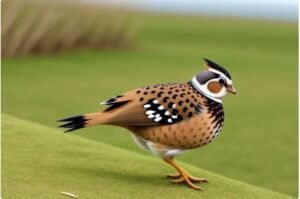
Bobwhite Quail: Bobwhite quail are native to North America and are valued for their sweet, nutty flavor and tender meat. While they may not grow as large as Coturnix quail, Bobwhites are popular among hunters and game bird enthusiasts for their distinctive call and adaptability to different habitats. They are often raised in large outdoor aviaries or released for hunting purposes.
Egg-Laying Breeds
Coturnix Quail (Japanese Quail): In addition to being excellent meat producers, Coturnix quail are also prolific egg layers, making them a popular choice for backyard egg farming enthusiasts. These small birds can begin laying eggs as early as six weeks of age and can produce up to 300 eggs per year, depending on environmental conditions and diet. Coturnix quail eggs are prized for their rich flavor and nutritional value, making them a gourmet addition to any kitchen.
Bobwhite Quail: While Bobwhite quail are primarily raised for their meat, they are also capable of laying eggs under the right conditions. Bobwhite hens typically lay smaller clutches of eggs compared to Coturnix quail, but their eggs are prized for their delicate flavor and nutritional content. Bobwhite quail eggs are often used in gourmet cuisine and are considered a delicacy in some regions.
Ornamental and Exhibition Breeds
Button Quail: Button quail, also known as Chinese painted quail, are miniature quail species prized for their colorful plumage and small size. These diminutive birds are often kept as pets or ornamental birds due to their charming appearance and entertaining behavior. Button quail come in a variety of color mutations, including silver, cinnamon, and pearl, and are popular among aviculture enthusiasts for their unique personalities.
California Quail: California quail, also known as Valley quail, are native to the western United States and are admired for their striking plumage and distinctive topknots. While they are primarily wild birds, California quail are sometimes kept in aviaries or as ornamental birds for their beauty and sociable nature. They are often featured in aviaries and wildlife exhibits for their captivating appearance and communal behaviors.
Choosing the Right Fowl Bird for You
Selecting the perfect fowl bird breed involves considering various factors, including temperament, space requirements, and intended purpose. To help you make an informed decision, let’s explore different scenarios and which fowl bird breeds might suit your needs:
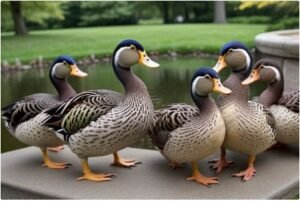
Scenario 1: Urban Dweller with Limited Space
If you reside in a bustling city with limited outdoor space, you’ll want a fowl bird breed that thrives in compact environments. Consider breeds like Silkies or Seramas, known for their small size and gentle disposition. These breeds are well-suited to urban living and can be kept in smaller coops or even raised in backyard gardens.
Scenario 2: Family with Children Seeking Friendly Pets
For families with children looking for friendly and docile pets, breeds like Orpingtons or Cochins are excellent choices. These breeds are known for their calm and friendly nature, making them ideal companions for children. Additionally, their fluffy plumage and gentle demeanor make them a delight to interact with, providing endless entertainment for the whole family.
Scenario 3: Homesteader Wanting Dual-Purpose Birds
If you’re a homesteader seeking fowl birds that can fulfill multiple roles, dual-purpose breeds are the way to go. Consider breeds like Australorps or Rhode Island Reds, prized for their excellent egg-laying abilities and flavorful meat. These breeds are ideal for individuals or families looking to sustainably produce their own food while enjoying the beauty of backyard poultry keeping.
Scenario 4: Hobby Farmer Looking for Ornamental Birds
For hobby farmers interested in raising fowl birds for ornamental purposes, breeds like Polish or Frizzles are perfect choices. With their unique and eye-catching appearances, these breeds add a touch of whimsy to any flock. While they may not be the most prolific egg layers or meat producers, their aesthetic appeal makes them prized additions to any poultry collection.
Scenario 5: Rural Resident Wanting Cold-Hardy Birds
If you live in a region with harsh winters and cold temperatures, prioritize breeds that are cold-hardy and resilient to chilly conditions. Consider breeds like Wyandottes or Plymouth Rocks, known for their robust nature and ability to withstand cold climates. These breeds are excellent choices for rural residents seeking fowl birds that can thrive year-round, even in the coldest of winters.
Scenario 6: Entrepreneurial Spirit Seeking Profitable Ventures
For individuals with an entrepreneurial spirit looking to start a business venture in poultry farming, selecting fowl bird breeds optimized for meat or egg production is crucial. Consider breeds that offer high yields and rapid growth rates to maximize profitability.

For Meat Production: opt for breeds like Cornish Cross chickens or Broad Breasted White turkeys, renowned for their exceptional meat quality and rapid growth rates. These breeds reach market weight quickly, making them ideal choices for meat production ventures. With proper management and marketing strategies, you can establish a lucrative business supplying high-quality poultry meat to local markets or restaurants.
For Egg Production: Focus on breeds prized for their prolific egg-laying abilities, such as Leghorns or Golden Comets. These breeds consistently produce large quantities of eggs, making them valuable assets for egg production enterprises. Whether you plan to sell eggs at farmers’ markets, distribute to grocery stores, or supply to bakeries and cafes, choosing the right egg-laying breed is essential for long-term success in the egg business.
Factors Influencing Choice
Several factors influence the choice of fowl bird breed, including:
- Space Requirements: Different fowl bird breeds have varying space requirements, ranging from compact backyard setups to extensive free-range environments.
- Climate Suitability: Consider the climate and weather conditions of your region to ensure the chosen breed can thrive in its environment.
- Purpose: Determine whether you intend to raise fowl birds for egg production, meat, pest control, or other purposes, as this will influence the breed selection process.
Note: The above-given Scenarios were designed and explained while keeping an eye on these factors.
Housing and Accommodation
Proper housing and accommodation are vital aspects of fowl bird care, ensuring their health, safety, and overall well-being. Here’s a detailed guide to setting up an ideal living environment for your feathered friends:
Coops and Enclosures
A sturdy and well-constructed coop or enclosure is the cornerstone of fowl bird housing. Consider the following factors when designing or selecting a coop:
- Size: Provide ample space for the flock to move around comfortably. Allow at least 2-4 square feet of indoor space per bird, with additional outdoor space for free-ranging if possible.
- Ventilation: Ensure adequate ventilation to prevent moisture buildup and maintain air quality. Install windows or vents to promote airflow while protecting against drafts.
- Protection: Secure the coop against predators such as foxes, raccoons, and birds of prey. Use sturdy materials for construction and install predator-proof fencing or wire mesh around the perimeter.
- Lighting: Natural light is beneficial for fowl birds’ health and egg production. Position the coop to maximize exposure to sunlight, and supplement with artificial lighting if necessary, especially during darker months.

House setup for fowl birds.
Nesting Areas
Create inviting nesting areas where fowl birds can lay their eggs comfortably and securely. Consider the following tips:
- Location: Place nest boxes or trays in a quiet and secluded area of the coop to provide privacy and reduce disturbances.
- Materials: Fill nesting boxes with soft bedding materials such as straw, hay, or wood shavings to cushion the eggs and encourage nesting behavior.
- Accessibility: Ensure easy access to nesting areas for egg collection and cleaning. Install hinged lids or removable panels for convenient maintenance.
Roosting Space
Roosting is a natural behavior for fowl birds, allowing them to rest and sleep off the ground. Here’s how to provide adequate roosting space:
- Elevation: Install roosts at varying heights to accommodate birds’ preferences. Use sturdy branches or wooden perches, positioned at least 12-18 inches above the ground.
- Spacing: Allow sufficient space between roosts to prevent overcrowding and ensure all birds have access. Aim for a minimum of 8-12 inches of space per bird.
- Cleanliness: Regularly clean and inspect roosting areas to remove droppings and debris. Maintaining cleanliness helps prevent the spread of disease and promotes healthy living conditions.
Feeding and Nutrition
Ensuring proper feeding and nutrition is crucial for the health and well-being of fowl birds, contributing to their growth, productivity, and overall vitality. Here’s a comprehensive overview of their dietary needs and recommended feeding practices:

Dietary Needs of Fowl Birds
Fowl birds, whether chickens, ducks, turkeys, or quails, require a well-balanced diet rich in essential nutrients. Key components of their dietary requirements include:
Protein: Like seeds for a plant, protein is the foundation for muscle development, egg production, and overall growth. opt for protein sources such as poultry pellets (which can include soybean meal, fish meal, and blood meal), which provide essential amino acids necessary for their health.
Carbohydrates: Serve as the energy source, akin to grains for plants, fueling daily activities and metabolic processes. Grains like corn, wheat, barley, and oats are excellent sources of carbohydrates for fowl birds, providing sustained energy throughout the day.
Vitamins and Minerals: Act as the vitamins and minerals act as the nutrients akin to soil and water for plants, playing vital roles in various physiological functions, including immune support, bone health, and feather quality. Ensure a balanced intake of vitamins A, D, E, and B-complex, as well as minerals like calcium (found in oyster shells or limestone), phosphorus, and potassium.
Water: Like water for plants, water is essential for hydration, digestion, and regulating body temperature. Provide clean, fresh water at all times to meet their high-water requirements, especially during hot weather or periods of egg-laying.
Note: To know perfect diet for specie specific pet birds: You can click here.
Pros:
Economic Benefits of Fowl Bird Husbandry
Cost-Effectiveness
- Fowl birds require minimal investment and maintenance costs compared to larger livestock.
- Their high reproductive rates ensure a steady supply of meat and eggs, enhancing cost-effectiveness.
Job Creation
- Small-scale poultry farming creates employment opportunities, particularly in rural areas.
- Local food markets benefit from the production and sale of fowl bird products, fostering entrepreneurship.
Economic Stimulus
- Fowl bird husbandry diversifies income sources for farmers, supporting local economies.
- It bolsters local supply chains and reduces dependency on external markets.
Other Benefits
- Therapeutic Value: Raising fowl birds offers hands-on learning experiences and therapeutic benefits.
- Environmental Sustainability: Fowl bird husbandry promotes eco-friendly practices like composting and pest management.
- Community Building: Participation in fowl bird keeping activities strengthens social bonds and fosters a sense of belonging.
Cons:
Time and Labor Intensive
- Raising fowl birds requires consistent attention and care, which can be time-consuming.
- Daily tasks such as feeding, cleaning, and monitoring health can add to workload demands.
Disease Management
- Fowl birds are susceptible to various diseases and infections, necessitating preventive measures and veterinary care.
- Outbreaks of contagious illnesses can result in significant economic losses and pose risks to other livestock.
Noise and Odor Concerns
- Fowl bird farms can generate noise and odor nuisances, particularly in residential areas.
- Complaints from neighbors or zoning restrictions may pose challenges for expanding or establishing fowl bird operations.
Conclusion:
Fowl birds offer a myriad of benefits ranging from egg and meat production to their role in fostering community engagement and environmental sustainability. By carefully selecting the right breeds, providing appropriate housing and nutrition, and leveraging the economic opportunities they present, individuals can embark on a fulfilling journey in fowl bird husbandry. Despite the numerous advantages, it’s essential to remain cognizant of potential challenges such as disease management and regulatory compliance. Nevertheless, with dedication, passion, and a commitment to responsible stewardship, raising fowl birds can not only be a rewarding endeavor but also a means of making positive contributions to both local communities and the broader environment.
FAQs:
Is a duck a fowl Bird?
Yes, a duck is indeed a fowl bird. Fowl birds encompass various domesticated and wild species, including ducks, chickens, turkeys, and geese, among others.
What is the definition of fowl bird?
The term "fowl bird" refers to domesticated or wild birds typically raised for meat, eggs, feathers, or as ornamental pets. It includes species like chickens, ducks, turkeys, and geese.
What are famous fowl birds?
Some famous fowl birds include chickens (such as Rhode Island Reds and Leghorns), ducks (like Pekin and Muscovy), turkeys (including Broad Breasted White and Bronze), and geese. These birds are commonly raised for food production, ornamental purposes, or as pets.
Is pigeon a fowl bird?
Yes, a pigeon is also considered a fowl bird. While it's often associated with urban environments, pigeons belong to the same avian category as chickens, ducks, and other fowl species.
What are the best fowl birds for meat production?
Some of the best fowl birds for meat production include the Broad Breasted White turkey, Cornish Cross chicken, and Pekin duck. These breeds are known for their fast growth rates, efficient feed conversion, and flavorful meat, making them popular choices for commercial and backyard farming operations.
What are the best fowl birds for egg production?
For egg production, breeds like the Leghorn chicken, Rhode Island Red, and White Leghorn are among the best choices. These breeds are prolific layers, known for consistently producing high-quality eggs throughout the year. Additionally, breeds like the Khaki Campbell duck and Coturnix quail are also renowned for their egg-laying capabilities.
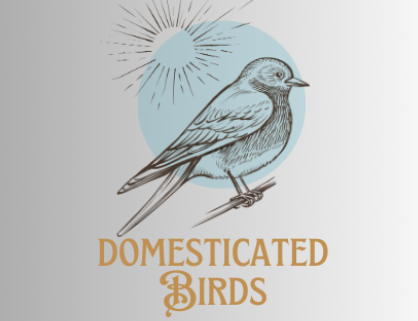
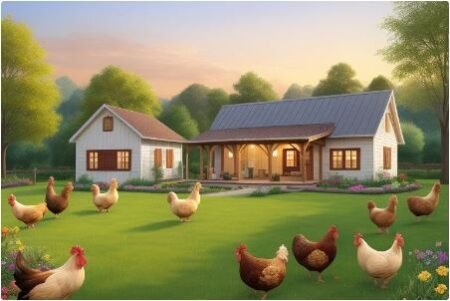
1 thought on “Fowl Birds: From Defining to Choosing to Setup – Productive Pets”